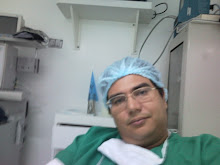MIsión Investigar, revisar y analizar publicaciones actualizadas y de trascendencia de Ginecología y obstetricia con la ayuda de la epidemiología y publicar nuestra opinión sobre ellas
jueves, 15 de diciembre de 2011
Articulo para revisar. La pregunta que intentamos responder es: ¿Como medimos el liquido libre en cavidad en la eco transvaginal?
ESTE ARTICULO Y BIBLIOGRAFÍA PUEDE AYUDARNOS, PROPONER OTROS ARTÍCULOS O REFERENCIAS
LINK
http://www.wjes.org/content/2/1/23
Ultrasound assessment of haemoperitoneum in ectopic pregnancy: derivation of a prediction model
Arnaud Fauconnier*, Ali Mabrouk, Laurent J Salomon, Jean-Pierre Bernard and Yves Ville
ABSTRACT
Background
To derive an ultrasound-based prediction model for the quantification of haemoperitoneum in ectopic pregnancy (EP).
Methods
Retrospective study of 89 patients operated upon EP between January 1999 and March 2003 in a French Gynaecology and Obstetrics department in a university hospital. Transvaginal sonograms, clinical and biological variables from patients with haemoperitoneum ≥ 300 ml at surgery were compared with those from patients with haemoperitoneum < 300 ml or no haemoperitoneum. Sensitivity, specificity, positive and negative likelihood ratios were calculated for each parameter after appropriate dichotomization. Multiple logistic regression analysis was used to select the best combination at predicting haemoperitoneum ≥ 300 ml.
Results
Three parameters predicted haemoperitoneum ≥ 300 ml independently: moderate to severe spontaneous pelvic pain, fluid above the uterine fundus or around the ovary at transvaginal ultrasound, and serum haemoglobin concentration < 10 g/dL. A woman with none of these three criteria would have a probability of 5.3% for haemoperitoneum ≥ 300 ml. When two or more criterias were present, the probability for haemoperitoneum ≥ 300 ml reached 92.6%.
Conclusion
The proposed model accurately predicted significant haemoperitoneum in patients diagnosed to have EP.
Etiquetas:
Ecografia,
hemoperitoneo
 MEDICO, GINECOLOGO, GERENTE DE SALUD DE LA UNIVERSIDAD DE CARTAGENA
EPIDEMILOGO DE LA CORPAS
PROFESOR DE LA UNIVERSIDAD DEL SINU
MEDICO, GINECOLOGO, GERENTE DE SALUD DE LA UNIVERSIDAD DE CARTAGENA
EPIDEMILOGO DE LA CORPAS
PROFESOR DE LA UNIVERSIDAD DEL SINU
Suscribirse a:
Enviar comentarios (Atom)
No hay comentarios:
Publicar un comentario